#humans on the moon by 1400 CE
Text
Mass Effect Trailer Thoughts
*EDIT* -- there are now TWO UPDATES to this post with additional screenshots, thoughts and theories, please check that one out! :)
I wrote an unhinged disorganized post before... now I’ll attempt breaking things down in a much more logical way. :D
1) It’s basically confirmed that this is both the Milky Way and Andromeda in the same shot.

2) The audio is some actual and I think some fictional mix of communications --
“We know now that in the early years of the 20th century, this world was being watched” is from War of the Worlds
“Eagle Houston, you are go for landing, over” is from the moon landing.
“Arcturus Station, uknown vessel approaching, we need first contact protocols” would probably be new dialog from the First Contact War.
“Humanity now stands as partners in the galaxy” is likely new dialog from after the end of the FC war when humanity was accepted as a Citadel species.
“Ark Six is away, godspeed” is new dialog, likely a reference to the Andromeda Initiative. There were six arks in the initiative.
3) This system isn’t in any of the first three games as far as I can tell -- and I logged into ME3 with the EGM mod wherein literally every system in all three games is used as extra content and looked at them all. Anyone recognize it?

4) This is anyone’s guess but... possibly... what’s through the Omega relay? the rings seem... very densely packed.
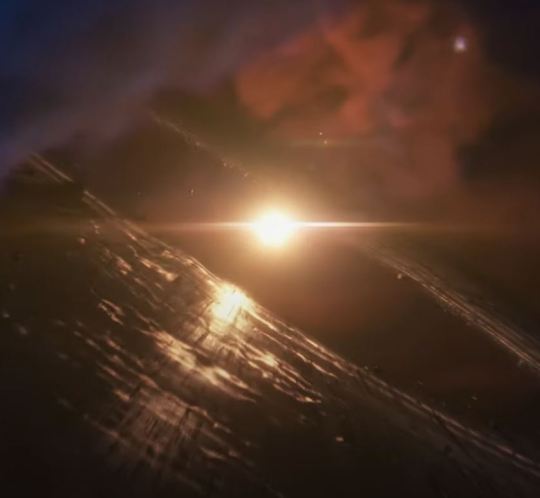
5)Two moons and a gas giant looking planet. I don’t even want to hazard a guess. The planet itself could look like Jupiter, but Jupiter has a lot more moons.
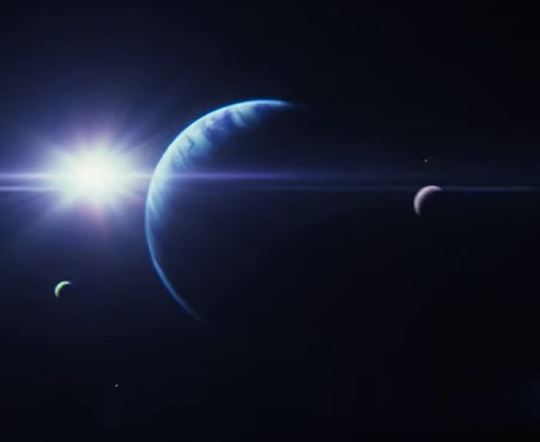
6) Then of course, we have the destroyed mass relay.

This comes with the dialog about taking down a dreadnaught, and (sensors?) are going crazy, and abandoning the ship, and then the REAPER SOUND.
Then “Is anyone receiving this? We’ve lost contact.”
So all of this felt like traveling through time, and here we finish Mass Effect 3.
7) Then comes this image... which again, does not really look like any system recognizable in any of the games.

An indistinguishable female voice says something about Humanity (something like “Humanity is all the problems its faced”? Maybe?) and a male voice... which sounds a little like Clancy Brown (Alec Ryder) to me, but... maybe I need to play through the Andromeda prologue again.
The slight break in the action there may be accounting for the 600 years passing before Andromeda.
The break in the action could also mean it’s something in the future of what we’ve seen, something new.
8) Now, we come to this planet.

There are THREE MOONS... and Alchera has three moons. Maybe this is a coincidence. Or maybe this is Alchera. It seems oddly specific for them to show the three moons in sequence if there wasn’t a reason for it.
9) It’s confirmed that Liara is walking up a reaper here. There ALSO appears to be a SECOND reaper in the background (look just above the sun, you can see reaper-like wires and follow that outline to see the other reaper’s legs.)
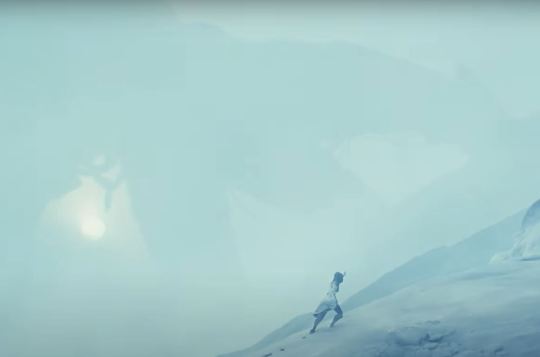
10) There appears to be more stuff, maybe N7 striped stuff, than just the fragment Liara picks up buried in the snow here.
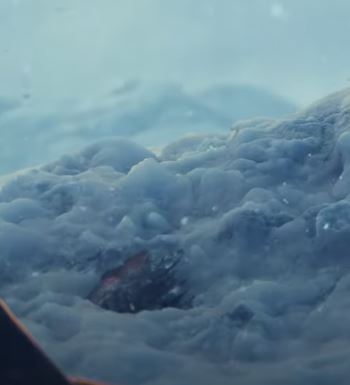
11) This may be a part of an N7 helmet, but it can’t be Shepard’s N7 helmet.

You get the helmet as a reward for finishing the Alchera DLC in ME2 (so basically, Shepard brings it along after planting the monument), and although the part is similar on the side here, it’s definitely not the same. This is Shepard’s helmet on the SR-2 in ME2, loaded it up and took the pics with flycam just to confirm.


14) That’s definitely a Salarian on the left and probably a Krogan on the right. Guesses for the center person... Human? Turian? Angaran? (Comedy answer: Javik? Though we don’t know how long Protheans lifespans are so... hey! Anything’s possible!)
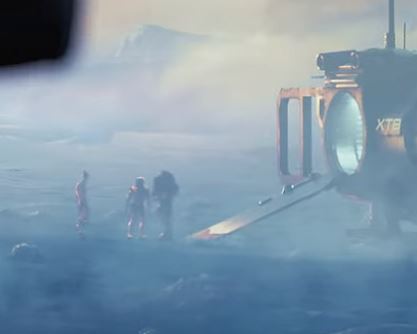
13) Liara has crow’s feet and laugh lines -- she’s most likely much older in this trailer than we saw her last in ME3. Perhaps... 600 - 700 years older? Grunt would likely be the only other ME/2/3 companion still alive. (Wrex was alive to fight in the end of the Krogan Rebellion in 700 CE, if this is post-Andromeda that would place him at over 2000 years old, I don’t think Krogan lifespans are that long. Drack is considered an old man at 1400. But it could be possible.)

So my best theory right now aligns with what I’ve seen other people guess -- this game will take place sometime after Andromeda and serve to bridge the two galaxies, but how that happens and why Liara is retrieving a piece of broken N7 armor is anyone’s guess. I have a few wildly unhinged theories myself. :D
2K notes
·
View notes
Text
Continuation from this post: some other “these events happened at about the same time or close together in history” things:
- The French Revolution happened shortly after the American Revolution, and the Haitian Revolution happened shortly after the French Revolution, and the big wave of revolution that freed Latin America from Spanish control happened shortly after the Haitian Revolution. I think this wasn’t a coincidence: these revolutions were connected!
- The first civilizations arose in Egypt and Mesopotamia at the end of the great drying of the Sahara and Arabia. Again, I think this wasn’t a coincidence! The drying climate meant people had to rely more on big labor-intensive irrigation works, which meant that cooperation and coordination on a large scale became more important. The great drying probably drove refugees into the Nile valley and the lands around the Tigris and Euphrates, increasing the population density of those regions. This would have meant even more reliance on labor-intensive large-scale irrigation, and also those extra people would have helped staff the work-gangs, work-shops, and armies of the new kings. The influx of refugees probably also meant a mixing of cultures, which probably stimulated technological, cultural, and institutional innovation.
- The peopling of the Americas and the first experiments with grain farming in the Middle East might have been happening at about the same time.
- The Norman conquest of England was within living memory at the time of the First Crusade.
- The Classical Maya period was 250-900 CE, roughly coinciding with the late Roman Empire and the Dark Ages in Europe. The collapse of the Classical Maya centers was during the 900s, about a century or two after Charlemagne’s time (IIRC the 900s CE is around the end of the Danelaw period in England).
- The moai (the big heads) of Easter Island aren’t ancient; they were built during the late Middle Ages and the early modern period.
- New Zealand was peopled during the Middle Ages, IIRC some centuries after the peopling of Iceland. New Zealand was one of the last lands on Earth to be peopled.
- Lady Murasaki lived in the late 900s and early 1000s CE; a little before the Norman conquest of England. To me Heian-period and pre-Heian Japan feels like the Bronze Age, but it’s from a completely different period of history; it existed in the same world as Vikings and Charlemagne and the Tang Dynasty; I think that’s interesting. Speaking of Japanese history, the Japanese warring states period and the height of classic samurai feudalism was the 1400s and 1500s.
- Australia was peopled at least 30,000 years before the Americas, and Homo sapiens expansion into northern Eurasia seems to have taken much longer than Homo sapiens peopling of Australia. There’s a lesson in this: cold seems to have been a more daunting barrier than ocean. That makes sense in a way: the Homo sapiens out-of-Africa migrants were likely tropical/subtropical coast-dwellers, and they could have just followed the tropical/subtropical southern coast of Asia all the way to Java (which you could have walked to from Asia back then because sea levels were lower), never leaving warm coastal regions. After that they would have needed just one big innovation to reach Australia: sea-worthy boats. Adapting to the cold northern regions of ice age Eurasia would have required more radical changes to their tool-kit and lifestyle. I think something similar happened in the Americas: there are surprisingly old signs of human presence in South America, and I suspect what happened is the first Americans were fisher-whaler-beachcomber people who lived on a stretch of ice-free coast between the Pacific and the ice age North American glaciers, and as they expanded they mostly just followed the coast south, and they kept doing that until some of them reached Tierra del Fuego within maybe a few centuries. If an alien visited Earth around 13,500 BCE I think they might have found a few tens of thousands of people living along the west coast of the Americas from Alaska to Tierra del Fuego and the rest of the Americas still almost uninhabited (maybe there’d be a few thousand people living in the inland hills of California and the inland jungles of Central America, but that’d be about it). Only the most adventurous early Americans moved inland, where they’d have to survive without the resources of the sea and the beach, and became the Clovis People and other inland early American hunter-gatherer cultures. I wouldn’t be surprised if there were humans living along the shores of the Straight of Magellan before there were humans living in the Sierra Nevada mountains of California.
A somewhat different but related thing: communicating the sheer length of ancient Egyptian history:
- Sargon the Great gets called the first empire-builder, but I think that title really should belong to Narmer, or whoever the first Pharaoh of a unified Egypt was. We often don’t think of Narmer as an empire-builder for the same reason we often don’t think of Qin Shi Huangdi’s great empire as an empire: the empire was so successful and enduring that it eventually started to look like a natural fact of human cultural geography. You know your empire has really succeeded when most people don’t think of it as an empire! Sargon the Great lived about 800 years after Narmer, so the difference in time between them is similar to the difference in time between Julius Caesar and Charlemagne.
- The Great Pyramids were built in the 2500s and early 2400s BCE, about 500 years after Narmer’s reign. This was early in Egyptian history! I think it’s interesting that the Egyptians did this huge construction project early in their history and never did anything like that again. I really wonder what happened there. Did building the Great Pyramids ruin the economy? Did the mobilization of the huge workforce needed to build the Great Pyramids stir up the disease pool and cause plagues (did something similar happen when Amarna was built and populated and did that contribute to the failure of the Atenist reformation?)? Anyway, like I said, the Great Pyramids were built relatively early in Egyptian history ... though the time difference between Narmer and the builders of the great pyramid was comparable to the difference in time between us and Columbus and Henry VIII!
- There were three most ancient centers of civilization that emerged at about the same time: Mesopotamia, Egypt, and the Indus Valley Civilization. The Indus Valley Civilization collapsed around 2000 BCE and we don’t know much about it; we can’t read their writing. I think it’d be fascinating if we could learn more about the Indus Valley Civilization! Were they politically fragmented, like Mesopotamia, or were they a single state, like Egypt? There’s some evidence that might suggest the latter, but it’s impossible to know! So many unanswered questions!
- The Thera eruption that might have contributed to the decline of Minoan civilization happened around 1600 BCE. This was around the same time as the Hyksos rule in northern Egypt; if I’m reading my Wikipedia skimming right there’s a record of the Thera eruption recorded on a stelae set up by the Pharaoh who reconquered northern Egypt from the Hyksos!
- Tutankhamun lived in the mid-1300s BCE. Tutankhamun lived more than a thousand years after the Great Pyramids were built! The builders of the Great Pyramids were as distant from Tutankhamun as the Vikings are from us!
- And Cleopatra (the famous one, Cleopatra VII) lived about 1300 years after Tutankhamun! Tutankhamun was as distant from Cleopatra as Charlemagne is from us! And the Great Pyramids were about 2500 years old in Cleopatra’s time; their construction was about as distant from her as Buddha, Confucius, and Socrates are from us! As that meme says: Cleopatra lived closer to the construction of the moon rockets than the construction of the Great Pyramids.
Remember when I said Pharaonic Egypt and the US kind of remind me of each other? Well, the US is less than 250 years from its founding. 250 years from the founding of the unified Egyptian state they’d just recently stopped doing human sacrifice (the earliest Pharaohs were buried with human retainer sacrifices, about a century or so into the Pharaonic period they stopped doing that and switched to burying the Pharaohs with little dolls that were supposed to substitute for the servants) and they were just building the Step Pyramid of Djoser, just beginning the pyramid-building tradition that would culminate in the Great Pyramids centuries later.
Alternately, the other culture that really reminds me of Pharaonic Egypt is China, and its Narmer-equivalent lived after Alexander the Great. The Chinese still have about 800 years to go before they can say their civilization-state is as enduring as Pharaonic Egypt!
I really wonder if the Pharaonic Egyptian religion would still be going strong if Christianity and Islam hadn’t come along. It survived for so long!
43 notes
·
View notes
Photo
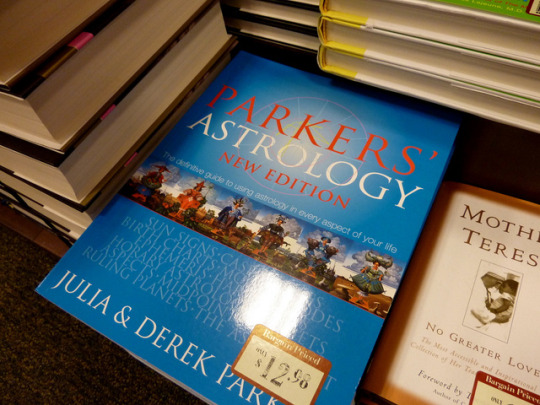
History of Astrology
“Many cultures have attached importance to astronomical events, and the Indians, Chinese, and Maya developed elaborate systems for predicting terrestrial events from celestial observations. In the West, astrology most often consists of a system of horoscopes purporting to explain aspects of a person's personality and predict future events in their life based on the positions of the sun, moon, and other celestial objects at the time of their birth. The majority of professional astrologers rely on such systems.[5]:83
Astrology has been dated to at least the 2nd millennium BCE, with roots in calendrical systems used to predict seasonal shifts and to interpret celestial cycles as signs of divine communications.[4] A form of astrology was practised in the first dynasty of Mesopotamia (1950–1651 BCE). Vedāṅga Jyotiṣa, is one of earliest known Hindu texts on astronomy and astrology (Jyotisha). The text is dated between 1400 BCE to final centuries BCE by various scholars according to astronomical and linguistic evidences. Chinese astrology was elaborated in the Zhou dynasty (1046–256 BCE). Hellenistic astrology after 332 BCE mixed Babylonian astrology with Egyptian Decanic astrology in Alexandria, creating horoscopic astrology. Alexander the Great's conquest of Asia allowed astrology to spread to Ancient Greece and Rome. In Rome, astrology was associated with 'Chaldean wisdom'. After the conquest of Alexandria in the 7th century, astrology was taken up by Islamic scholars, and Hellenistic texts were translated into Arabic and Persian. In the 12th century, Arabic texts were imported to Europe and translated into Latin. Major astronomers including Tycho Brahe, Johannes Kepler and Galileo practised as court astrologers. Astrological references appear in literature in the works of poets such as Dante Alighieri and Geoffrey Chaucer, and of playwrights such as Christopher Marlowe and William Shakespeare.
Throughout most of its history, astrology was considered a scholarly tradition. It was accepted in political and academic contexts, and was connected with other studies, such as astronomy, alchemy, meteorology, and medicine.[6] At the end of the 17th century, new scientific concepts in astronomy and physics (such as heliocentrism and Newtonian mechanics) called astrology into question. Astrology thus lost its academic and theoretical standing, and common belief in astrology has largely declined.[11]“ - wikipedia
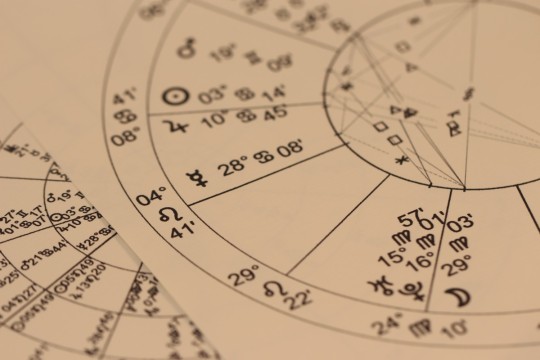
Ancient world
“See also:Babylonian astrology
Astrology, in its broadest sense, is the search for meaning in the sky.[20]:2,3 Early evidence for humans making conscious attempts to measure, record, and predict seasonal changes by reference to astronomical cycles, appears as markings on bones and cave walls, which show that lunar cycles were being noted as early as 25,000 years ago.[21]:81ff This was a first step towards recording the Moon's influence upon tides and rivers, and towards organising a communal calendar.[21] Farmers addressed agricultural needs with increasing knowledge of the constellations that appear in the different seasons—and used the rising of particular star-groups to herald annual floods or seasonal activities.[22] By the 3rd millennium BCE, civilisations had sophisticated awareness of celestial cycles, and may have oriented temples in alignment with heliacal risings of the stars.[23]
Scattered evidence suggests that the oldest known astrological references are copies of texts made in the ancient world. The Venus tablet of Ammisaduqa is thought to be compiled in Babylon around 1700 BCE.[24] A scroll documenting an early use of electional astrology is doubtfully ascribed to the reign of the Sumerian ruler Gudea of Lagash (c. 2144 – 2124 BCE). This describes how the gods revealed to him in a dream the constellations that would be most favourable for the planned construction of a temple.[25] However, there is controversy about whether these were genuinely recorded at the time or merely ascribed to ancient rulers by posterity. The oldest undisputed evidence of the use of astrology as an integrated system of knowledge is therefore attributed to the records of the first dynasty of Mesopotamia (1950–1651 BCE). This astrology had some parallels with Hellenistic Greek (western) astrology, including the zodiac, a norming point near 9 degrees in Aries, the trine aspect, planetary exaltations, and the dodekatemoria (the twelve divisions of 30 degrees each).[26] The Babylonians viewed celestial events as possible signs rather than as causes of physical events.[26]
The system of Chinese astrology was elaborated during the Zhou dynasty (1046–256 BCE) and flourished during the Han Dynasty (2nd century BCE to 2nd century CE), during which all the familiar elements of traditional Chinese culture – the Yin-Yang philosophy, theory of the five elements, Heaven and Earth, Confucian morality – were brought together to formalise the philosophical principles of Chinese medicine and divination, astrology and alchemy.[27]:3,4
Ancient objections
Cicero stated the twins objection (that with close birth times, personal outcomes can be very different), later developed by Saint Augustine.[28] He argued that since the other planets are much more distant from the earth than the moon, they could have only very tiny influence compared to the moon's.[29] He also argued that if astrology explains everything about a person's fate, then it wrongly ignores the visible effect of inherited ability and parenting, changes in health worked by medicine, or the effects of the weather on people.[30]
Plotinus argued that since the fixed stars are much more distant than the planets, it is laughable to imagine the planets' effect on human affairs should depend on their position with respect to the zodiac. He also argues that the interpretation of the moon's conjunction with a planet as good when the moon is full, but bad when the moon is waning, is clearly wrong, as from the moon's point of view, half of its surface is always in sunlight; and from the planet's point of view, waning should be better, as then the planet sees some light from the moon, but when the moon is full to us, it is dark, and therefore bad, on the side facing the planet.[31]
Favorinus argued that it was absurd to imagine that stars and planets would affect human bodies in the same way as they affect the tides,[32] and equally absurd that small motions in the heavens cause large changes in people's fates. Sextus Empiricus argued that it was absurd to link human attributes with myths about the signs of the zodiac.[33] Carneades argued that belief in fate denies free will and morality; that people born at different times can all die in the same accident or battle; and that contrary to uniform influences from the stars, tribes and cultures are all different.[34]“ - wikipedia
#wikipedia#astrology#wicca#wisdom#witchcraft#witch#wiccan#wican#pagan#paganism#palmistry#palm reading#astronomy#relationships#love#Psychic#psychic readings#psychic readers#psychic advice#master psychic#Magic#magical#magick#magik#magi#knowledge
9 notes
·
View notes
Text
The Goddesses of Inca Mythology
The Inca civilization flourished in the Andes mountains of South America between 1400 CE, and the early 1500's. Inca society was a theocratic society, meaning that politics and religion were completely intertwined. The Inca religion combined features of animism, fetishism, and the worship of nature gods representing forces of nature. The state religion focused on the worship of a many major figures, of which the goddesses played a major role.
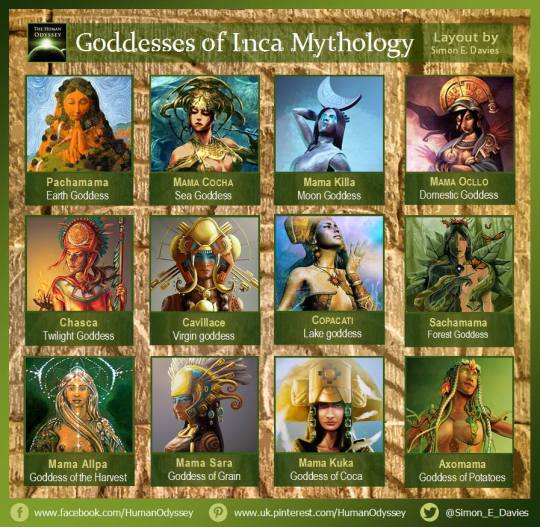
Pachamama was an earth goddess, associated with seasons, fertility, planting and harvesting. Her form embodied the mountains, and was also known to cause earthquakes. She was one of the primordial deities of the Inca pantheon, who sustained all life on earth. The Inca believed that problems arose when people took too much from nature, thus placing a great strain on Pachamama.
Mama Cocha was another primordial deity, who resided over the sea. She protected fishermen and sailors, making sure that they had plenty of fish, preventing storms, and calming the seas. She was said to have dominion over all bodies of water (i.e. rain, rivers and seas), which were said to have healing properties. As the wife of the supreme God Viracocha, Mama Cocha was the mother of Mama Quilla, Goddess of the moon, and her brother Inti, God of the sun.
Mama Killa resided over marriage and the menstrual cycle, and was considered a defender of women. Her lunar cycle helped the Inca people calculate the passage of time, upon which many rituals were based. The Inca people loved Mama Killa and believed that a lunar eclipse marked a moment where a mountain lion or serpent was attacking her. To protect their beloved moon goddess, they would attempt to scare it away by throwing weapons, gesturing wildly and making as much noise as possible. They feared that if the beast ever achieved its aim, then the world would be left in darkness.
Mama Ocllo was a fertility Goddess who founded the Inca capital Cuzco with her husband/brother Manco Capac. Legend says she gave Manco Capac a golden staff, telling him that wherever he could sink the staff into the ground with one push, he should build a temple to the sun. Once this sacred spot was found, Manco Capac and Mama Ocllo gathered the people together at Cuzco, and Mama Ocllo taught the women how to weave clothes and harvest crops.
Chasca ("The long-haired Star") was the goddess of the dawn and twilight, linked to the planet Venus. She was the protectress of virgins and young girls, and associated with spring and renewal. She uses light to draw sprouts from the ground and inspire blossoms. She was regarded as a love goddess, and according to lore, she communicates to people through clouds and dew in a type of geomantic divination.
Cavillace was a virgin goddess. She ate a fruit, which was actually the sperm of Coniraya, a fertility god. When she gave birth to a son, she demanded that the father step forward. No one did, so she put the baby on the ground, and it crawled towards Coniraya. She was ashamed because of Coniraya's low stature among the gods, and ran to the coast of Peru, where she changed herself and her son into rocks.
Copacati was a lake Goddess, who represented the great waters of Lake Titicaca. She was often represented by images of serpents or snakes and legend says she sunk a whole town into the waters of the great lake, making her a figure to be both feared and revered.
Sachamama was the goddess of the forest, whose name means 'mother tree'. Legend says she grew so large, she can no longer move about the jungle and stayed in a single spot, allowing vegetation to grow over her body. If unsuspecting passersby got too close, Sachamama would devour them whole. She would remain for hundreds of years in the same place, and when she stood upright, she would take on the form of the world tree.
Mama Allpa was an Earth Goddess, who nourishes all life. She is depicted with multiple breasts, and represents the womb of the world. This links her with other many breasted goddesses, such as Ishtar (Mesopotamian) and Artemis (Greek). She helped to bring about a bountiful harvest, feeding the masses of the Inca Empire.
Mama Sara ("maize mother") was the Goddess of grain and fertility, associated with maize. When a stick of maize developed multiple growths, it was said to look like the head and limbs of Mama Sara. In such cases, the Inca people would dress the maize like a doll, treating it as a manifestation of Mama Sara.
Mama Kuka was a coca Goddess, associated with health and joy. In Incan mythology Mama Kuka was originally a promiscuous woman who was cut in half by her many lovers. From her body grew the first coca plant the leaves of which are chewed to boost energy and are used by the Andean priests in ritual offerings known as k'intus.
Axomama was one of the daughters of Pachamama. Her name literally means Potato mother. Potatoes were a vital food source for the Incan people, and most villages would have a particularly odd-shaped potato to worship, embodying the spirit of Axomama. They would pray to this idol for a good harvest.
The majority of the goddesses in the Inca pantheon represented fertility and abundance. In order to maintain this plentiful living, the goddesses needed to be satisfied via the sacrifice of precious goods and animals, especially llamas. Humans were also sacrificed (albeit it on a smaller scale than other American cultures), by hitting them on the head while under the effects of alcohol. The hope was that they would be in a state of happiness when they first encountered their beloved goddess.
--
If you’re looking for a really immersive experience of world mythology, why not subscribe to my Patreon page, and gain:
Access to in-depth posts on the gods, monsters & heroes of world myth
Entry to my FB group on the 'Tales of the Monomyth,' AKA the first story ever told
A 'behind the scenes' peek at my upcoming novels & much much more!
www.patreon.com/HumanOdyssey
--
ARTWORK
Saryth Chareonpanichkul
Gonzalo Ordóñez Arias
Octavio Cordova
Javier Sama
Juanco
7 notes
·
View notes
Text
non-western art: teotihuacan + nazca cultures.
For this assignment, I chose to research Teotihuacan and Nazca cultural art.
teotihuacan, a mesoamerican metropolis.
Teotihuacan culture was based in a city of the same name, homed in Central America, about 50 kilometers (30 miles) northeast of modern day Mexico City. It is the largest pre-Columbian site in the Americas, and was the largest city in the entirety of the Western Hemisphere before the 1400s. It thrived for the first half of the first millennium A.D. Based on our best evidence today, we believe Teotihuacan to have been established around 150 BCE, lasting to about the middle of the 6th century. Nearly 200,000 people lived in the city at its peak. (Wikipedia)
Teotihuacan is, for nearly all parts considered, a ghost story. The city, a sprawling grid of over 30 km² (over 11½ square miles), was already in ruins, abandoned for nearly a thousand years before the Aztecs came upon it. So much of the Teotihuacanos is unknown: “they had no form of writing, so much of their politics, culture, and religion were lost or co-opted by later civilizations.” (Vance) Archaeological excavations have led to some recent significant discoveries; it is believed that sometime in the 7th or 8th century, the city was heavily burnt, seemingly by invaders, but recent findings shows that the damage was focused towards the structures of the elite were burnt, which leans towards convincing evidence of an uprising, but is still just a theory. (Wikipedia)
teotihuacan, in its prime.
From what we can see, and by what has been found, Teotihuacan is believed to have been home to a wide, diverse set of cultures, including Zapotec, Mixtec, Maya and Nahua distinctions, but this is still heavily debated.
Chief Curator of the Fowler Museum at UCLA, Matthew Robb, was the exhibition curator for the exhibition Teotihuacan: City of Water, City of Fire, at the de Young museum in San Francisco, in late 2017. When asked about how the art and culture of Teotihuacan invited new, diverse variety to the city, he said: “Not very many people in ancient Mesoamerica woke up and lived their lives in an apartment compound covered with interior wall paintings, but a lot of people in Teotihuacan did. And that’s just the murals—many compounds had small domestic altars, and certain kinds of stone sculptures were pervasive across all social levels. It was a materially and visually rich environment—there are even reduced-scale versions of vessels and objects included in burials.” (Gardiner)
At the time, Teotihuacan was a Mesoamerican metropolis. In its prime, the city was a bustling aspirational utopia of culture: the cultural, political, economic, and religious epicenter of ancient Mesoamerica. It was home to a visually rich environment, in more ways than just art. Houses had courtyards and drains, goods came from all around the city: minerals from the north, shells from the coast, jade from the Maya region. There were ball games and gambling, religious worshipping temples, many different types of food, various entertainments, it all made for a comfortable life to start thinking about bigger ideas than just survival. Teotihuacan was a shot at a better life for many people. (Moran)
teotihuacan architecture.

A Map of Teotihuacan, de Young Museum.
Architecturally, Teotihuacan contains a massive central road, thousands of residential compounds many pyramid-temples. We don’t know their true names, but we have those that the Aztecs gave them. The massive central road is known famously as the Street of the Dead, and the two main pyramid-temples are known as the Temple of the Sun and the Temple of the Moon. Even Teotihuacan is a given Aztec name, meaning "Place of the Gods”.
The grid layout of the city is incredibly organized and neat. The entire city is orientated 15.5 degrees East of true north. The main avenue, or the Street of the Dead, is massive, spanning 40 meters wide and 3.2 km long. (Teotihuacán) It spans from agricultural fields all the way towards the city’s main citadel, housing the pyramid-temple of the Sun, and culminating at the pyramid-temple of the Moon.
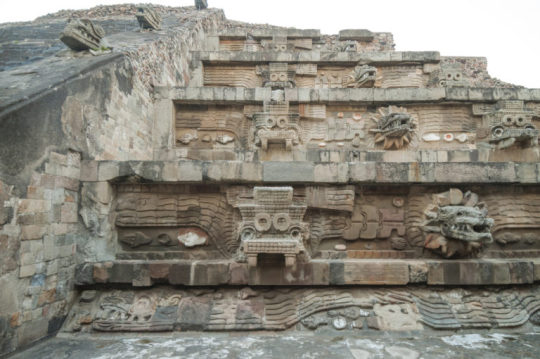
Temple of the Feathered Serpent, displaying "Tlaloc" (left) and feathered serpent (right) heads. Teotihuacan, Mexico, Mesoamerica.
Although it is the smallest of the three pyramid-temples along the Street of the Dead, the Pyramid of Quetzalcoatl (or the Temple of the Feathered Serpent, Quetzalcoatl), as well as its surrounding central plaza, are home to the greatest concentration of Teotihuacan’s sculptural and painted iconography. (Google Arts & Culture) Architectural sculpture attached to the temple are more than just decorative, displaying "Tlaloc" and feathered serpent heads. There are indents in the eyes for the placement of light-reflecting gems. It is believed that they suggest a strong ideological significance, but the significance itself remains highly debated. (Temple of the Feathered Serpent)
teotihuacan sculpture.
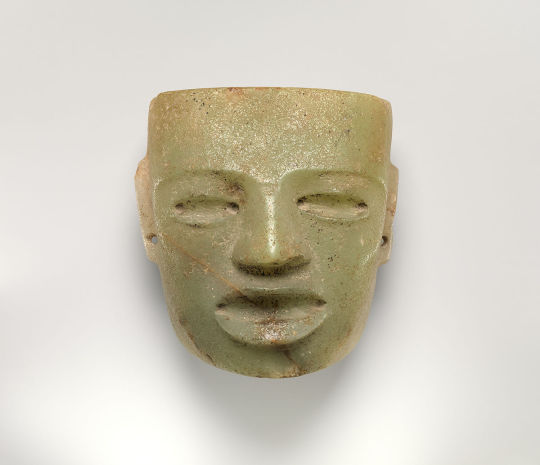
Mask, 4th–8th century, Teotihuacan, Mexico, Mesoamerica. Onyx marble (tecalli). The Metropolitan Museum of Art.
Sculptures were varied, as there was no tradition of portraiture in Teotihuacan culture. Masks were made in this idealized style, we believe, to be a representation towards a status symbol, or towards a standardized art motif of the time. It is carved out of Onyx marble, a precious stone, and may have been painted at one point. Depressions in the eyes and mouth may suggest that they were once homes for inlaid shells, stones, or other precious stones. There are perforations on the sides, intending that the mask may have not been worn by people, but instead attached to further sculptures; human figures, mummies, or deity bundles. (Doyle)
teotihuacan paintings.
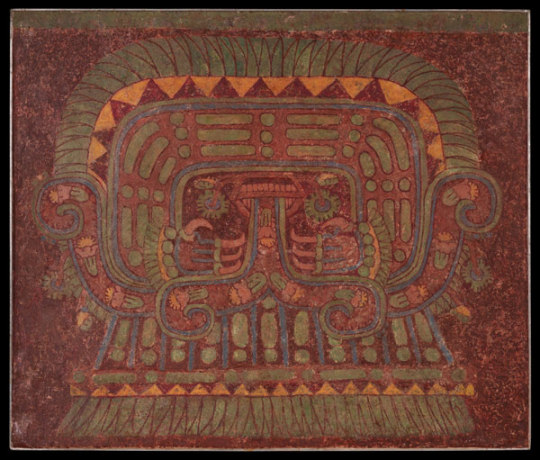
Wall painting, 7th–8th century. Teotihuacan, Mexico, Mesoamerica. The Metropolitan Museum of Art, New York.
Paintings can be found everywhere in Teotihuacan culture: on walls, on statues, on various kinds of ceramics. The painting above, is an example of the many floor-to-ceiling murals that cover the walls of many of the high-status apartment compounds, frescoed murals depicting elaborate scenes and enigmatic iconography. (Doyle)
teotihuacan ceramics.

Vessel from Tlaxcala with procession of figures, 550–650 CE. Fine Arts Museums of San Francisco (FAMSF).
Ceramics were a vivid, expressive venue of Teotihuacan art. Stylistically, the range of variety and high quality of painting and production showed mastery and expertise in the creation of ceramics: “Teotihuacan culture boasted a range of ceramic styles. Luxury ceramics could feature abstract figures rendered in vivid colors. There are also painted ceramics that are similar to frescoes, mold-made ceramics, very large and ornate multi-part incense burners, as well as architectural ceramics.” (Eiland)
contemporary references to teotihuacan.

Ralph Maradiaga Mini-Park, 24th & York. Mosaic sculpture, Colette Crutcher and Aileen Barr, 2010.
In San Francisco’s Mission District, various artists have paid homage to Teotihuacan culture. A mosaic sculpture done by artists Colette Crutcher and Aileen Barr, shows an interpretation of Quetzalcoatl, the feathered serpent god the Teotihuacanos worshipped.
The architecture of Teotihuacan can tell us so much about how the way we build our cities has evolved over time. Concepts like harmony, time-lasting material, and significance still have merit in our cities today. Look outside, see the way buildings are angled, or arched, or how high they climb in comparison to their surroundings and backdrops. The similarities are everywhere.

The Moon Pyramid and complex in Minecraft, de Young Museum.
The study and historical significance of Teotihuacan’s culture, architecture, and artwork of its diverse population is incredibly important. But not all of us can see it in our lifetimes, due to monetary restrictions or general life-work restrictions. Because of this, the exhibition curators at the de Young museum in San Francisco, California, made a 1:1 scale replication in Minecraft. The size, the scale, the recent discoveries, are all there for people worldwide to experience, with custom texture pack for a realistic representation of stone and artwork textures. Talk about incredible dedication and hard work to bring Teotihuacan to the world!
nazca culture.
Nazca civilization was homed in South America, near the coastal river valleys and high mountain basins of Peru. It flourished from about 100 BC to 800 AD. The style generally associated with the art of the Nazca – polychrome textiles, ceramics, architectural irrigation technologies – drew heavily from their contemporary, then-predecessors, the Andean society of Paracas.
The Nazca period was one of artistic flourishment and technological advancement. Religiously, the Nazca drew likely inspiration from their desert environment, beliefs based on agriculture and fertility. (Wikipedia) Many worshipped nature gods in favor of growth of crops and agriculture.
Politically, Nazca civilization was headed by a collection of chiefdoms, who worked both individually and collectively when the time called for it. There was no singular large-scale or integrated position of power. There was no centralized city. Instead, the overall population of about 25,000 people were spread across small villages. The Nazca were a state of the theocratic militaristic power sort, leadership often being those held in high qualification, usually priests and military leaders. (Cartwright)
Small cities of the Nazca civilization usually included many domestic amenities, including ceremonial mounds, walled courts, and terraced housing. It was also home to engineered aqueducts, including the Cantalloc Aqueducts, but there were more than 40 different built to ensure the supply of water to the city and to the surrounding agricultural fields, where cotton, beans, potatoes, and other crops grew. There were many opportunities in small cities for artisans, including ceramists, architects, weavers, astrologists, and musicians, to work for the leadership. Those who were not artisans, were usually farmers and fishermen, the fundamental base of the Nazca economical society. Pieces of pottery and textiles that have been found with resources originating far from Peruvian valleys (rainforest bird feathers, and mountain-homed alpaca and llama wool, etc.) serve as examples of evidence of trade with other cultures. (Cartwright)
nazca ceramics, goldsmithing, and textiles.

Curved Beaker with Rows of Abstract Masks and Geometric Motifs, 180 BC/500 AD. The Art Institute of Chicago.
The tradition of ceramics in Nazca culture was one of stunning high-quality polychrome pottery, with the use of eleven gradations of various colors in various pieces. Shapes included “double-spout bottles, bowls, cups, vases, effigy forms, and mythical creatures”. (Wikipedia) Pieces usually feature motifs, drawing from the environment, myth, religion, geometric, or deity representation.
Nazca ceramics were made before the use of wheels, and instead done by building coil walls up, then smoothing them out, before sometimes adding a smooth layer of soft clay for painting. Their reflective, smooth and shiny surfaces were made with the process of careful burnishing, or polishing/rubbing during the late drying stages. Many of the best-conserved examples we’ve found have been preserved in graves, buried with the mummified dead, either in dug graves or in tombs.

Nose Ornaments in the Form of Feline Whiskers, 180 BC/500 AD., The Art Institute of Chicago.
Gold and silver were also used in ceremonial and religious traditions, worn in the style of jewelry: masks, ear flaps, nose rings, or other adornments. To be worn they were flattened, cut, and embossed.
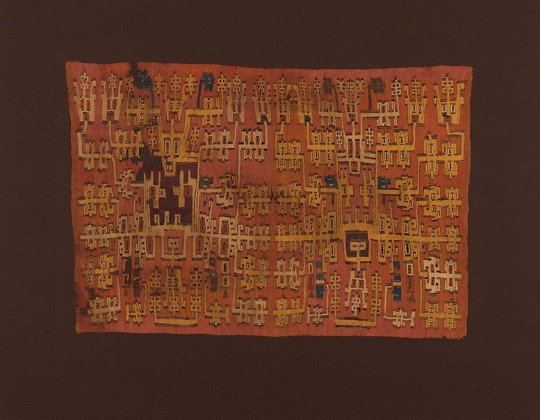
Panel, 500/600 AD, The Art Institute of Chicago.
Textiles were produced with cotton and wool, using techniques of muslin, brocading, tapestry, embroidery, painted cloth, and tridimensional weaving. Thread was dyed various different colors. Textiles, alike Nazca ceramics, usually portrayed themes, or motifs, worn for religious ceremonies or rituals. Excavations have found spindles, looms, needles, cotton, and pots of dyes at various Nazca sites. (Cartwright)
The panel above displays human-animal duality, portraying anthropomorphic abstract figures. The orientation can be shifted and still understood due to the range of horizontal symmetry. The many different heads featured are meant to signify supernatural, otherworldly powers, leaning towards this piece having ritualistic significance. (Art Institute of Chicago)
the nazca lines.

Of course, it is difficult to talk about Nazca culture, and not immediately turn to the famed Nazca lines; large geoglyphs seen only from an aerial vantage point, spanning over 50 miles, that have remained intact over the last 2000 years. The lines were made by clearing – with incredible detail – the red rocks of the Sechura (Nazca) desert, and exposing the greyish sand beneath. The geoglyphs are incredibly geometric, consisting of images that are of zoomorphic (animal-based) and phytomorphic (trees, flowers, etc.) shapes. (Bahadur)
The meaning of the lines has been heavily debated over the last handful of decades: leaning towards agricultural, to sacred rites for aquifers and springs, to astronomical and calendrical theories. National Geographic explorer Johan Reinhard summarized the versatile meaning of the lines in his book The Nazca Lines: A New Perspective on their Origin and Meaning: “No single evaluation proves a theory about the lines, but the combination of archaeology, ethnohistory, and anthropology builds a solid case.” (Reinhard) The way we see the world and our past continually adds onto itself, and with further research and a little bit of luck, we will hopefully find the origin and true meaning of the Nazca lines in the relative future.
Works Cited:
“Art and identity in the ancient city of Teotihuacan.” Gardiner Museum Blog, Gardiner Museum. 2018. URL.
“Teotihuacan, Mexico.” Google Arts and Culture, Google. Dec 2009. URL.
Bahadur, Tulika. “The Nazca Lines.” On Art and Aesthetics. eLucidAction. 8 May, 2016, URL.
Cartwright, Mark. “Nazca Civilization.” Ancient History Encyclopedia, Ancient History Encyclopedia Limited, 23 May 2014. URL.
Doyle, James. “The Arts of a Mesoamerican Metropolis, Here at the Met.” The Met, The Metropolitan Museum of Art, 19 Nov. 2014. URL.
Eiland, Murray Lee. “Ceramics from the Birthplace of the Gods.” Ceramics Monthly, The Ceramic Arts Network, 8 Jan 2019. URL.
Moran, Barbara. “Lessons from Teo.” The Brink, Boston University, 6 Oct 2015. URL.
Reinhard, Johan. The Nazca Lines: A New Perspective on their Origin and Meaning. Editorial Los Pinos, 1986.
Vance, Erik. “An Homage to Teotihuacan.” Sapiens, Wenner-Gren Foundation for Anthropological Research, Inc. 5 July 2018. URL.
Wikipedia editors. “Temple of the Feathered Serpent, Teotihuacan.” Wikipedia, Wikimedia, 7 Sep. 2019. URL.
Wikipedia editors. “Teotihuacán.” Wikipedia, Wikimedia, 4 Sep. 2019. URL.
Wikipedia editors. “Nazca Culture.” Wikipedia, Wikimedia, 16 May 2019. URL.
Art Cited:
Curved Beaker with Rows of Abstract Masks and Geometric Motifs, 180 BC/500 AD. The Art Institute of Chicago, Chicago. URL.
Explore Teotihuacan at Home with Minecraft, de Young Museum. 21 Sep, 2017. URL.
Mask. 4th–8th century, The Metropolitan Museum of Art, New York. URL.
Mosaic sculpture, Colette Crutcher and Aileen Barr, Fine Arts Museums of San Francisco. URL.
Nose Ornaments in the Form of Feline Whiskers, 180 BC/500 AD., The Art Institute of Chicago, Chicago. URL.
Panel, 500/600 A.D. The Art Institute of Chicago, Chicago. URL.
The Sun Pyramid. Jorge Pérez de Lara Elías, Flickr. URL.
Vessel with Procession of Figures. 4th–8th century, Fine Arts Museums of San Francisco, San Francisco, California. URL.
0 notes
Text
Eight Simple Steps To Prevent Mold Growth In Your Home

Mesopotamia. 3900 BCE. Some lucky schmuck with a cereal grain farm accidentally brews the worlds first beer, probably due to wild yeasts in the air. He became very popular with his neighbors and threw legendary parties.
Egypt. 1391 BCE. An artisan took a nasty fall from the scaffolding of a sphinx he was chiseling and was rushed by his coworkers to Imhotep, a celebrated swnw, the ancient Egyptian equivalent to a physician(albeit one who’s methods included magic spells). Dr Imhotep took a look at the many cuts and scrapes his patient had suffered, grabbed a big hunk of moldy bread, and assured the poor dude that he would be infection free.
France. 879 CE. Distracted by a beautiful girl while taking his lunch break in a cave, a young Frenchman abandoned his cheese to give chase. Many moons later, he returned to the cave and decided to eat his leftovers. They were delicious. Thanks to Penicillium roqueforti mold, the world’s first blue cheese, Roquefort, had been created. Salad eaters the world over rejoiced.
London. 1928 CE. Professor Alexander Fleming was sorting through his vast and varied collection of petri dishes at St Mary’s Hospital like a kid going through his comic book collection. Another day, another colony of Staphylococcus. This day, however, contained a surprise. One of the petri dishes contained an odd mold growth, which seemed to be repelling the Staphylococcus bacteria. Later, he managed to collect a concentrated amount of the bacteria killing mold juice, which he called “Penicillin.”

Yeast and mold both come from the fungus kingdom, reproducing via lightweight spores. While yeast is loved for it’s bread and beer making abilities, Mold is the fungus among us with a shady reputation. However, as illustrated by the above historical examples, some molds, like yeast, are good friends to us humans. We live with more than 300,000 varieties of mold on planet Earth. It’s quite pervasive and can be found in any environment. Without a doubt, this fungus is in your house right now, and I’m not talking about beer, antibiotics, or cheese.
Don’t panic. Mold spores need to find a nice wet area to settle into with organic material to feed on in order to grow and spread. The degree to which a concentration of mold may be a problem for you depends on who’s living in your home. For most of us, if we have a reaction to mold at all, it’s a respiratory issue indistinguishable from seasonal allergies. It may be a mild irritation, but you can live with it. Mold becomes problematic when it’s concentrated in a home with young children, the elderly, asthmatics, or folks with compromised immune systems.
Stachybotrys, or black mold, is particularly notorious but rare. The mold itself is not toxic, but the mycotoxins it excretes are. The big fear of black mold stems from a 1999 incident in Cleveland, OH, where two infants were thought to have been killed by black mold. However, further review by the Center for Disease Control in the year 2000 found that the case in Cleveland was flawed, and there is no direct evidence that black mold was the guilty party. Other studies have shown that black mold mycotoxins can cause hemorrhaging in the lungs of animals but only in high concentrations.

The takeaway here is that while some molds are problematic, you can and do live with most mold without much trouble. Still, finding ugly mold stains in your home is disparaging, and if you want to sell that home, mold is definitely a problem which will require a professional remediation in order to rid the infected areas of your home and prevent mold from returning.
So, how can you prevent mold growth in your home? Mold needs moisture and organic material to feed on in order to thrive. You need to remove these ingredients as best as you can, so:
Keep a clean house. Even dust contains organic matter, so stay on top of it, and clean up any spills as soon as they happen.
Change dish rags, wash cloths, and bath towels regularly.
Don’t leave food out more than 2-3 hours. Seal it in containers when you put it in the fridge.
Fix leaky pipes and take precautions to keep your home dry. In extreme cases, this may require landscaping to slope water away from your house.
Remove carpet from humid spots in your house, like a bathroom or laundry room.
Use dehumidifiers. Keeping humidity under 60% is a good goal, but the lower, the better.
Utilize exhaust fans in the kitchen and bathroom when cooking, washing dishes, or taking a shower. Any appliance that requires venting, should be venting outdoors.
Use mold resistant paint. This is particularly helpful in the kitchen, basement, bathrooms, and laundry room.
Holland, MI. 2019 CE. Randy’s Carpet Care has been performing professional mold remediation for nearly 40 years. Live in West Michigan and suspect a mold problem in your home? Call Randy’s Carpet Care to schedule a free remediation estimate. (616) 392-1400

#mold#black mold#fungus#yeast#blue cheese#penicillin#ancient#Egypt#Mesopotamia#beer#Alexander Fleming#Imhotep#randy's carpet care#prevention
0 notes
Text
New Post has been published on THIẾT BỊ KHOA HỌC CÔNG NGHỆ
New Post has been published on http://thietbikhoahoccongnghe.com.vn/danh-sach-118-nguyen-hoa-hoc-da-biet.html
Danh sách 118 nguyên tố hoá học đã biết
Bảng phân loại sau đây cho biết 118 nguyên tố hoá học đã biết.
Số, tên và biểu tượng nguyên tử đều phục vụ độc lập dưới dạng các số nhận dạng duy nhất.
Tên được chấp nhận bởi IUPAC; tên tạm thời cho các yếu tố sản xuất gần đây chưa chính thức được đặt tên trong dấu ngoặc đơn.
Nhóm, khoảng thời gian, và khối liên quan đến vị trí của một phần tử trong bảng tuần hoàn. Số nhóm ở đây hiển thị số được chấp nhận hiện tại; đối với số cũ thay thế, hãy xem
Nhóm (bảng tuần hoàn).
Trạng thái vật chất (rắn, lỏng, hoặc khí) áp dụng ở điều kiện nhiệt độ và áp suất tiêu chuẩn (STP).
Xảy ra, các chỉ định bởi một chú thích bên cạnh tên của phần tử, phân biệt một cách tự nhiên xảy ra các yếu tố, phân loại các yếu tố tổng hợp nguyên thủy một trong hai hoặc thoáng qua (từ phân rã), và thêm que đã được sản xuất công nghệ, nhưng không biết là xảy ra một cách tự nhiên.
Actinide, kim loại kiềm, kim loại kiềm thổ, lanthanit, kim loại sau khi chuyển đổi, kim loại, khí quyển, kim loại phi đa hình hoặc phi kim loại tảo, và kim loại chuyển tiếp.
List of chemical elements Z[I] Symbol Element Origin of name[38][39] Group Period Atomic weight[40][41](u (±)) Density(g/cm3) Melt(K) [42] Boil (K) C[I](J/g · K) χ[I] Abundance in Earth’s crust[II](mg/kg) 1 H Hydrogen composed of the Greek elements hydro- and -gen meaning ‘water-forming’ 1 1 1.008[III][IV][V][VI] 0.00008988 14.01 20.28 14.304 2.20 1400 2 He Helium the Greek helios, ‘sun’ 18 1 4.002602(2)[III][V] 0.0001785 —[VII] 4.22 5.193 – 0.008 3 Li Lithium the Greek lithos, ‘stone’ 1 2 6.94[III][IV][V][VIII][VI] 0.534 453.69 1560 3.582 0.98 20 4 Be Beryllium beryl, a mineral 2 2 9.0121831(5) 1.85 1560 2742 1.825 1.57 2.8 5 B Boron borax, a mineral 13 2 10.81[III][IV][V][VI] 2.34 2349 4200 1.026 2.04 10 6 C Carbon the Latin carbo, ‘coal’ 14 2 12.011[III][V][VI] 2.267 3800 4300 0.709 2.55 200 7 N Nitrogen the Greek nitron and ‘-gen’ meaning ‘niter-forming’ 15 2 14.007[III][V][VI] 0.0012506 63.15 77.36 1.04 3.04 19 8 O Oxygen from the Greek oxy-, both ‘sharp’ and ‘acid’, and -gen, meaning ‘acid-forming’ 16 2 15.999[III][V][VI] 0.001429 54.36 90.20 0.918 3.44 461000 9 F Fluorine the Latin fluere, ‘to flow’ 17 2 18.998403163(6) 0.001696 53.53 85.03 0.824 3.98 585 10 Ne Neon the Greek neos, meaning ‘new’ 18 2 20.1797(6)[III][IV] 0.0008999 24.56 27.07 1.03 – 0.005 11 Na Sodium the English word soda (natrium in Latin) 1 3 22.98976928(2) 0.971 370.87 1156 1.228 0.93 23600 12 Mg Magnesium Magnesia, a district of Eastern Thessaly in Greece 2 3 24.305[VI] 1.738 923 1363 1.023 1.31 23300 13 Al Aluminium from alumina, a compound (originally aluminum) 13 3 26.9815385(7) 2.698 933.47 2792 0.897 1.61 82300 14 Si Silicon from the Latin silex, ‘flint’ (originally silicium) 14 3 28.085[V][VI] 2.3296 1687 3538 0.705 1.9 282000 15 P Phosphorus the Greek phoosphoros, ‘carrying light’ 15 3 30.973761998(5) 1.82 317.30 550 0.769 2.19 1050 16 S Sulfur the Latin sulphur, ‘fire and brimstone’ 16 3 32.06[III][V][VI] 2.067 388.36 717.87 0.71 2.58 350 17 Cl Chlorine the Greek chloros, ‘greenish yellow’ 17 3 35.45[III][IV][V][VI] 0.003214 171.6 239.11 0.479 3.16 145 18 Ar Argon the Greek argos, ‘idle’ 18 3 39.948(1)[III][V] 0.0017837 83.80 87.30 0.52 – 3.5 19 K Potassium New Latin potassa, ‘potash’ (kalium in Latin) 1 4 39.0983(1) 0.862 336.53 1032 0.757 0.82 20900 20 Ca Calcium the Latin calx, ‘lime’ 2 4 40.078(4)[III] 1.54 1115 1757 0.647 1 41500 21 Sc Scandium Scandia, the Latin name for Scandinavia 3 4 44.955908(5) 2.989 1814 3109 0.568 1.36 22 22 Ti Titanium Titans, the sons of the Earth goddess of Greek mythology 4 4 47.867(1) 4.54 1941 3560 0.523 1.54 5650 23 V Vanadium Vanadis, an Old Norse name for the Scandinavian goddess Freyja 5 4 50.9415(1) 6.11 2183 3680 0.489 1.63 120 24 Cr Chromium the Greek chroma, ‘color’ 6 4 51.9961(6) 7.15 2180 2944 0.449 1.66 102 25 Mn Manganese corrupted from magnesia negra, see Magnesium 7 4 54.938044(3) 7.44 1519 2334 0.479 1.55 950 26 Fe Iron English word (ferrum in Latin) 8 4 55.845(2) 7.874 1811 3134 0.449 1.83 56300 27 Co Cobalt the German word Kobold, ‘goblin’ 9 4 58.933194(4) 8.86 1768 3200 0.421 1.88 25 28 Ni Nickel from Swedish kopparnickel, containing the German word Nickel, ‘goblin’ 10 4 58.6934(4) 8.912 1728 3186 0.444 1.91 84 29 Cu Copper English word (Latin cuprum) 11 4 63.546(3)[V] 8.96 1357.77 2835 0.385 1.9 60 30 Zn Zinc the German Zink 12 4 65.38(2) 7.134 692.88 1180 0.388 1.65 70 31 Ga Gallium Gallia, the Latin name for France 13 4 69.723(1) 5.907 302.9146 2673 0.371 1.81 19 32 Ge Germanium Germania, the Latin name for Germany 14 4 72.630(8) 5.323 1211.40 3106 0.32 2.01 1.5 33 As Arsenic English word (Latin arsenicum) 15 4 74.921595(6) 5.776 1090 [IX] 887 0.329 2.18 1.8 34 Se Selenium the Greek selene, ‘moon’ 16 4 78.971(8)[V] 4.809 453 958 0.321 2.55 0.05 35 Br Bromine the Greek bromos, ‘stench’ 17 4 79.904[VI] 3.122 265.8 332.0 0.474 2.96 2.4 36 Kr Krypton the Greek kryptos, ‘hidden’ 18 4 83.798(2)[III][IV] 0.003733 115.79 119.93 0.248 3 1×10−4 37 Rb Rubidium the Latin rubidus, ‘deep red’ 1 5 85.4678(3)[III] 1.532 312.46 961 0.363 0.82 90 38 Sr Strontium Strontian, a small town in Scotland 2 5 87.62(1)[III][V] 2.64 1050 1655 0.301 0.95 370 39 Y Yttrium Ytterby, Sweden 3 5 88.90584(2) 4.469 1799 3609 0.298 1.22 33 40 Zr Zirconium Persian Zargun, ‘gold-colored’; German Zirkoon, ‘jargoon‘ 4 5 91.224(2)[III] 6.506 2128 4682 0.278 1.33 165 41 Nb Niobium Niobe, daughter of king Tantalus from Greek mythology 5 5 92.90637(2) 8.57 2750 5017 0.265 1.6 20 42 Mo Molybdenum the Greek molybdos meaning ‘lead’ 6 5 95.95(1)[III] 10.22 2896 4912 0.251 2.16 1.2 43 Tc Technetium the Greek tekhnètos meaning ‘artificial’ 7 5 [98][X] 11.5 2430 4538 – 1.9 ~ 3×10−9[XI] 44 Ru Ruthenium Ruthenia, the New Latin name for Russia 8 5 101.07(2)[III] 12.37 2607 4423 0.238 2.2 0.001 45 Rh Rhodium the Greek rhodos, meaning ‘rose coloured’ 9 5 102.90550(2) 12.41 2237 3968 0.243 2.28 0.001 46 Pd Palladium the then recently discovered asteroid Pallas, considered a planet at the time 10 5 106.42(1)[III] 12.02 1828.05 3236 0.244 2.2 0.015 47 Ag Silver English word (argentum in Latin) 11 5 107.8682(2)[III] 10.501 1234.93 2435 0.235 1.93 0.075 48 Cd Cadmium the New Latin cadmia, from King Kadmos 12 5 112.414(4)[III] 8.69 594.22 1040 0.232 1.69 0.159 49 In Indium indigo 13 5 114.818(1) 7.31 429.75 2345 0.233 1.78 0.25 50 Sn Tin English word (stannum in Latin) 14 5 118.710(7)[III] 7.287 505.08 2875 0.228 1.96 2.3 51 Sb Antimony uncertain: perhaps from the Greek anti, ‘against’, and monos, ‘alone’, or the Old French antimoine, ‘Monk’s bane’ (stibium in Latin) 15 5 121.760(1)[III] 6.685 903.78 1860 0.207 2.05 0.2 52 Te Tellurium Latin tellus, ‘earth’ 16 5 127.60(3)[III] 6.232 722.66 1261 0.202 2.1 0.001 53 I Iodine French iode (after the Greek ioeides, ‘violet’) 17 5 126.90447(3) 4.93 386.85 457.4 0.214 2.66 0.45 54 Xe Xenon the Greek xenos, ‘strange’ 18 5 131.293(6)[III][IV] 0.005887 161.4 165.03 0.158 2.6 3×10−5 55 Cs Caesium the Latin caesius, ‘sky blue’ 1 6 132.90545196(6) 1.873 301.59 944 0.242 0.79 3 56 Ba Barium the Greek barys, ‘heavy’ 2 6 137.327(7) 3.594 1000 2170 0.204 0.89 425 57 La Lanthanum the Greek lanthanein, ‘to lie hidden’ 3 6 138.90547(7)[III] 6.145 1193 3737 0.195 1.1 39 58 Ce Cerium the then recently discovered asteroid Ceres, considered a planet at the time 6 140.116(1)[III] 6.77 1068 3716 0.192 1.12 66.5 59 Pr Praseodymium the Greek praseios didymos meaning ‘green twin’ 6 140.90766(2) 6.773 1208 3793 0.193 1.13 9.2 60 Nd Neodymium the Greek neos didymos meaning ‘new twin’ 6 144.242(3)[III] 7.007 1297 3347 0.19 1.14 41.5 61 Pm Promethium Prometheus of Greek mythology who stole fire from the Gods and gave it to humans 6 [145][X] 7.26 1315 3273 – 1.13 2×10−19[XI] 62 Sm Samarium Samarskite, the name of the mineral from which it was first isolated 6 150.36(2)[III] 7.52 1345 2067 0.197 1.17 7.05 63 Eu Europium Europe 6 151.964(1)[III] 5.243 1099 1802 0.182 1.2 2 64 Gd Gadolinium Johan Gadolin, chemist, physicist and mineralogist 6 157.25(3)[III] 7.895 1585 3546 0.236 1.2 6.2 65 Tb Terbium Ytterby, Sweden 6 158.92535(2) 8.229 1629 3503 0.182 1.2 1.2 66 Dy Dysprosium the Greek dysprositos, ‘hard to get’ 6 162.500(1)[III] 8.55 1680 2840 0.17 1.22 5.2 67 Ho Holmium Holmia, the New Latin name for Stockholm 6 164.93033(2) 8.795 1734 2993 0.165 1.23 1.3 68 Er Erbium Ytterby, Sweden 6 167.259(3)[III] 9.066 1802 3141 0.168 1.24 3.5 69 Tm Thulium Thule, the ancient name for Scandinavia 6 168.93422(2) 9.321 1818 2223 0.16 1.25 0.52 70 Yb Ytterbium Ytterby, Sweden 6 173.045(10)[III] 6.965 1097 1469 0.155 1.1 3.2 71 Lu Lutetium Lutetia, the Latin name for Paris 6 174.9668(1)[III] 9.84 1925 3675 0.154 1.27 0.8 72 Hf Hafnium Hafnia, the New Latin name for Copenhagen 4 6 178.49(2) 13.31 2506 4876 0.144 1.3 3 73 Ta Tantalum King Tantalus, father of Niobe from Greek mythology 5 6 180.94788(2) 16.654 3290 5731 0.14 1.5 2 74 W Tungsten the Swedish tung sten, ‘heavy stone’ (W is wolfram, the old name of the tungsten mineral wolframite) 6 6 183.84(1) 19.25 3695 5828 0.132 2.36 1.3 75 Re Rhenium Rhenus, the Latin name for the river Rhine 7 6 186.207(1) 21.02 3459 5869 0.137 1.9 7×10−4 76 Os Osmium the Greek osmè, meaning ‘smell’ 8 6 190.23(3)[III] 22.61 3306 5285 0.13 2.2 0.002 77 Ir Iridium Iris, the Greek goddess of the rainbow 9 6 192.217(3) 22.56 2719 4701 0.131 2.2 0.001 78 Pt Platinum the Spanish platina, meaning ‘little silver’ 10 6 195.084(9) 21.46 2041.4 4098 0.133 2.28 0.005 79 Au Gold English word (aurum in Latin) 11 6 196.966569(5) 19.282 1337.33 3129 0.129 2.54 0.004 80 Hg Mercury the New Latin name mercurius, named after the Roman god (Hg from former name hydrargyrum, from Greek hydr-, ‘water’, and argyros, ‘silver’) 12 6 200.592(3) 13.5336 234.43 629.88 0.14 2 0.085 81 Tl Thallium the Greek thallos, ‘green twig’ 13 6 204.38[VI] 11.85 577 1746 0.129 1.62 0.85 82 Pb Lead English word (plumbum in Latin) 14 6 207.2(1)[III][V] 11.342 600.61 2022 0.129 1.87 14 83 Bi Bismuth Uncertain, possibly Arabic or German 15 6 208.98040(1)[X] 9.807 544.7 1837 0.122 2.02 0.009 84 Po Polonium Named after the home country of Marie Curie (Polonia, Latin for Poland), who is also the discoverer of Radium 16 6 [209][X] 9.32 527 1235 – 2.0 2×10−10[XI] 85 At Astatine the Greek astatos, ‘unstable’ 17 6 [210][X] 7 575 610 – 2.2 3×10−20[XI] 86 Rn Radon From radium, as it was first detected as an emission from radium during radioactive decay 18 6 [222][X] 0.00973 202 211.3 0.094 2.2 4×10−13[XI] 87 Fr Francium Francia, the New Latin name for France 1 7 [223][X] 1.87 300 950 – 0.7 ~ 1×10−18[XI] 88 Ra Radium the Latin radius, ‘ray’ 2 7 [226][X] 5.5 973 2010 0.094 0.9 9×10−7[XI] 89 Ac Actinium the Greek aktis, ‘ray’ 3 7 [227][X] 10.07 1323 3471 0.12 1.1 5.5×10−10[XI] 90 Th Thorium Thor, the Scandinavian god of thunder 7 232.0377(4)[X][III] 11.72 2115 5061 0.113 1.3 9.6 91 Pa Protactinium the Greek protos, ‘first’, and actinium, which is produced through the radioactive decay of protactinium 7 231.03588(2)[X] 15.37 1841 4300 – 1.5 1.4×10−6[XI] 92 U Uranium Uranus, the seventh planet in the Solar System 7 238.02891(3)[X] 18.95 1405.3 4404 0.116 1.38 2.7 93 Np Neptunium Neptune, the eighth planet in the Solar System 7 [237][X] 20.45 917 4273 – 1.36 ≤ 3×10−12[XI] 94 Pu Plutonium Pluto, a dwarf planet in the Solar System (then considered the ninth planet) 7 [244][X] 19.84 912.5 3501 – 1.28 ≤ 3×10−11[XI] 95 Am Americium The Americas, as the element was first synthesized on the continent, by analogy with europium 7 [243][X] 13.69 1449 2880 – 1.13 0[XII] 96 Cm Curium Pierre Curie, a physicist, and Marie Curie, a physicist and chemist, named after great scientists by analogy with gadolinium 7 [247][X] 13.51 1613 3383 – 1.28 0[XII] 97 Bk Berkelium Berkeley, California, where the element was first synthesized, by analogy with terbium 7 [247][X] 14.79 1259 2900 – 1.3 0[XII] 98 Cf Californium California, where the element was first synthesized 7 [251][X] 15.1 1173 (1743)[XIII] – 1.3 0[XII] 99 Es Einsteinium Albert Einstein, physicist 7 [252][X] 8.84 1133 (1269)[XIII] – 1.3 0[XII] 100 Fm Fermium Enrico Fermi, physicist 7 [257][X] (9.7)[XIII] (1125)[XIII] – – 1.3 0[XII] 101 Md Mendelevium Dmitri Mendeleev, chemist and inventor 7 [258][X] (10.3)[XIII] (1100)[XIII] – – 1.3 0[XII] 102 No Nobelium Alfred Nobel, chemist, engineer, innovator, and armaments manufacturer 7 [259][X] (9.9)[XIII] (1100)[XIII] – – 1.3 0[XII] 103 Lr Lawrencium Ernest O. Lawrence, physicist 7 [266][X] (15.6)[XIII] (1900)[XIII] – – 1.3 0[XII] 104 Rf Rutherfordium Ernest Rutherford, chemist and physicist 4 7 [267][X] (23.2)[XIII] (2400)[XIII] (5800)[XIII] – – 0[XII] 105 Db Dubnium Dubna, Russia 5 7 [268][X] (29.3)[XIII] – – – – 0[XII] 106 Sg Seaborgium Glenn T. Seaborg, scientist 6 7 [269][X] (35.0)[XIII] – – – – 0[XII] 107 Bh Bohrium Niels Bohr, physicist 7 7 [270][X] (37.1)[XIII] – – – – 0[XII] 108 Hs Hassium Hesse, Germany, where the element was first synthesized 8 7 [277][X] (40.7)[XIII] – – – – 0[XII] 109 Mt Meitnerium Lise Meitner, physicist 9 7 [278][X] (37.4)[XIII] – – – – 0[XII] 110 Ds Darmstadtium Darmstadt, Germany, where the element was first synthesized 10 7 [281][X] (34.8)[XIII] – – – – 0[XII] 111 Rg Roentgenium Wilhelm Conrad Röntgen, physicist 11 7 [282][X] (28.7)[XIII] – – – – 0[XII] 112 Cn Copernicium Nicolaus Copernicus, astronomer 12 7 [285][X] (23.7)[XIII] – ~357[XIV] – – 0[XII] 113 Nh Nihonium the Japanese name for Japan, Nihon, where the element was first synthesized 13 7 [286][X] (16)[XIII] (700)[XIII] (1400)[XIII] – – 0[XII] 114 Fl Flerovium Flerov Laboratory of Nuclear Reactions, part of JINR where the element was synthesized; itself named for Georgy Flyorov, physicist 14 7 [289][X] (14)[XIII] – ~210 – – 0[XII] 115 Mc Moscovium Moscow Oblast, Russia, where the element was first synthesized 15 7 [290][X] (13.5)[XIII] (700)[XIII] (1400)[XIII] – – 0[XII] 116 Lv Livermorium Lawrence Livermore National Laboratory (in Livermore, California) which collaborated with JINR on its synthesis 16 7 [293][X] (12.9)[XIII] (709)[XIII] (1085)[XIII] – – 0[XII] 117 Ts Tennessine Tennessee, United States 17 7 [294][X] (7.2)[XIII] (723)[XIII] (883)[XIII] – – 0[XII] 118 Og Oganesson Yuri Oganessian, physicist 18 7 [294][X] (5.0)[XIII][XV] – (350)[XIII] – – 0[XII]
0 notes